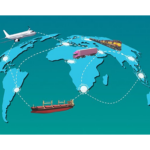Globally, healthcare executives are planning for strategic partnerships and technology investment to mitigate risks and capitalize on growth opportunities. And one such opportunity is managing pain points in the supply chain.
The healthcare supply chain is facing three major pain points, according to a recent survey conducted by UPS (7th annual UPS “Pain in the (Supply) Chain” survey), global logistics provider: an environment of increasing risks, complex regulations and continuing cost pressures.

Speaking to Medical Device Summit, Robin Hooker – Director, Healthcare Segment Marketing for UPS, said that regulatory compliance has been cited as the main pain point for the third consecutive year, cited by 60 percent of respondents to the survey.
“The most significant factors contributing to uncertainty in the healthcare supply chain are more stringent regulations and increased product protection challenges. Among the survey respondents, 78 percent cited regulatory compliance and increasing regulations as a top trend driving business and supply chain changes. Product protection also is increasingly challenging in a highly global marketplace, with 46 percent citing product security as a top challenge and 40 percent citing product damage and spoilage as a top concern,” Hooker explained.
A second major reason is economic. “Nearly half of those surveyed are still feeling an impact from the economic downturn six years later,” cites Hooker. The highest percentage of respondents to express this are located in the U.S., where 60 percent of healthcare logistics decision makers referred to economic concerns (globally it was 44 percent).
Despite operating in a risk-inherent environment, only 26 percent of healthcare executives cite contingency planning as a top supply chain concern. However, 34 percent of those surveyed in Asia, and 22 percent in Latin America, responded that more than a fourth of their companies’ supply chains were affected by unplanned events in the past three to five years.
Why focus on supply chain
“Facing the trifecta of challenges – increasing regulatory requirements, cost pressures and product security – and against the backdrop of the 2.3 percent device tax being levied the past year, there is now a new level of scrutiny across the organization to cut costs. In this situation, headcount and R&D budgets are being trimmed, and the next natural focus area is supply chain.
“On the other side, device makers are dealing with changes on the selling side – with changing relationships with providers and hospital networks, new reimbursement processes, and evolving sales models where there’s the constant pressures to lower prices. So there is understandably a lot of pressure to lean on the supply chain, to bring product to market more efficiently and address all regulatory challenges,” Hooker explains.
Opportunities in the healthcare supply chain
The survey highlighted opportunities that are yet to be tapped in the healthcare sector, such as leveraging new distribution channels and models to meet changing customer demands as e-commerce, urbanization and home healthcare grow.
- New distribution channels: While 70 percent or more of those surveyed both this year, and last year have indicated that they plan to increase their usage of new distribution channels, their channel mix remained nearly identical over these periods. This demonstrates that while the intention is present to change, actual change, however, is slow.
- Home healthcare growth: The rise of home healthcare is taking off with growth surges expected over the next decade. Globally, 21 percent of survey respondents cite the shift to home healthcare as a key trend driving business and supply chain changes.
- Collaborative partnerships: In 2011, 62 percent of decision makers surveyed cited working with or increased reliance on a third party logistics provider as a top strategy for the next few years, with 60 percent citing it as a successful strategy over the past 18 months. According to this year’s findings, 59 percent cite it as a strategy over the past 18 months and also over the next few years, indicating that while the healthcare industry recognizes the importance of implementing these strategies to increase competitiveness, companies are slow to act.
- Global market expansion: Over the past 18 months, 65 percent have tapped into new global markets to expand their customer base in order to drive new revenue growth. Looking ahead, 78 percent will expand to new global markets over the next three to five years.
Hooker adds that emerging markets have huge potential. “For a 3PL provider like UPS, we have enormous expertise and experience in emerging markets, and can assure device makers to enter new markets with us to offer customized services for their supply chain.”
Also, as the sector is seeing growing mergers and acquisitions as firms are aligning around shared synergies, companies are realizing that it’s better to invest in a company that is working with cutting-edge technology, and to partner with a firm that is an expert in warehousing and distributions, Hooker explains.
The medical device sector has been slow to outsource its supply chain management, but will increasingly do so, feels Hooker. “The trend will continue and the momentum will move things forward, especially given that the device tax will continue to place pressure on cost and efficiency,” he describes.





